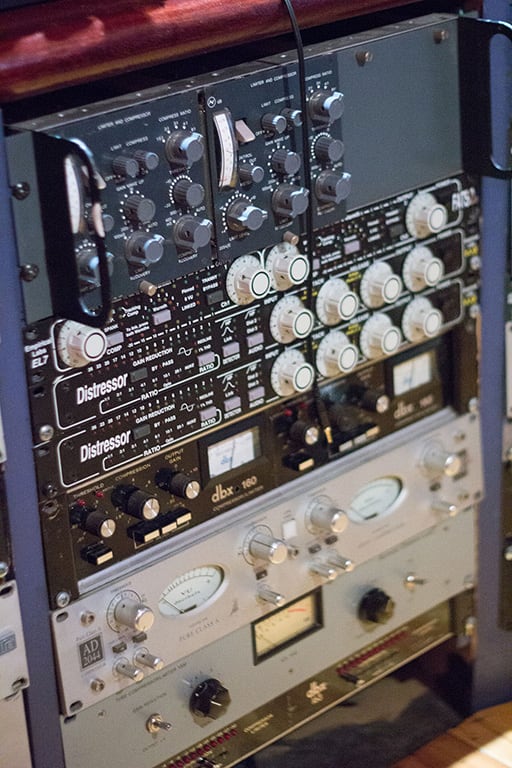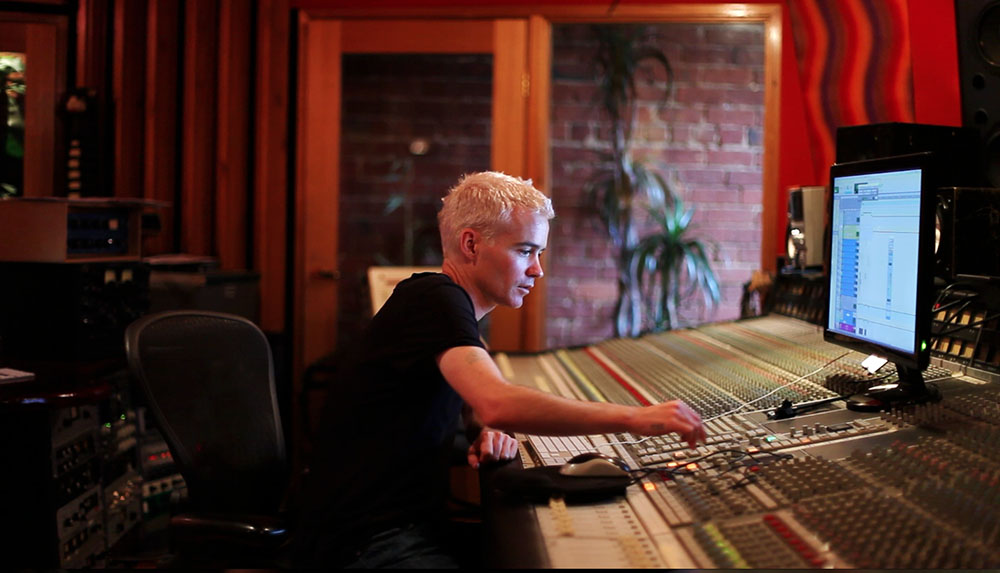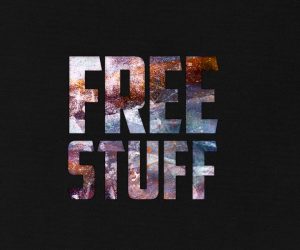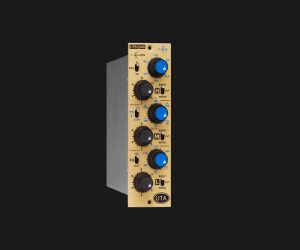
It’s About Time
The Avalanches’ second album, Wildflower, took 16 years to put together, making the mix process as nostalgic as the samples on the record.
Way back when, at the turn of the century, The Avalanches were on a roll. The group had struck a groove with their first album, Since I Left You, extracting the nostalgia scavenged from op shop vinyl bins and black and white movies into imaginary scenes full of heartwarming triggers. What’s more, their eclectic sample mashups were actually great songs. The key sampled phrase from half-mental single Frontier Psychiatrist, ‘That boy needs therapy’, became as hardwired into the turn of the century alternative zeitgeist as a Destiny’s Child melody was for the mainstream.
Madonna name checked them, Questlove put Since I Left You on his list of 10 favourite albums of all time; the Avalanches were poised to capitalise on the success.
While the juices were still flowing, core member Robbie Chater presented the others — including sole remaining co-contributor Tony Di Blasi — with a CD-R of jams; like talking points for the new record. “I was thinking, ‘This is great, we’re going to have a new album done in no time,’” said Chater. “There were so many great new tunes on there. We probably could have taken that as the basis and released a record.”
“I guess we got sidetracked,” downplayed Di Blasi, in likely one of the biggest understatements you’ll ever hear. It took them a whopping 16 years to finally release that follow up album, Wildflower.
It wasn’t because the songs weren’t good enough to make the cut. The basis for the song Saturday Night Inside Out was the first track on that CD, and its core was strong enough to survive those 16 years intact. “It was the first we heard of the new Avalanches stuff, and it ended up being the last song on this new record all those years later,” recalled Di Blasi.
CIRCLING THE FINISH LINE
Finishing art can be difficult, and releasing it can be even tougher. Self doubt took an early hold of Chater who became suspicious of anything that came too easily. “All those tunes came so effortlessly,” he said of the early CD. “I thought they couldn’t be any good because I wasn’t really trying. Then, of course, you try really hard and it’s over thought and overworked. You learn the hard way.”
It’s an incredibly long time for a song to sit around, so how do you keep it going for that long? “You don’t,” explained Chater. “You forget about them, and then over time the good ones make you remember them.” Over that length of time, everything gets recycled as a sample, whether it was picked from an op shop bin or not. “On Sunshine, Tony played Kontakt parts and I cut them up, then we forgot about the song for a few years.” said Chater. “We came back to it and it formed a small section that became the song. We looked at it — Tony’s Kontakt parts with my samples — as a new sample that would be turned into a new song.”
In many ways, the huge gap between records is conceivable when you consider the detective work required to craft a similar album. Watching countless black and white movies to find footsteps with the right amount of click, and perfect amount of clack, only to seat them as far in the background as they can go, requires the patience and attention to detail of a scale model maker. Heap sickness and financial woes on top of the process, and it’s a wonder it got done at all. Even after a weekend gig at Splendour with 20,000 people bopping along to Frankie Sinatra, it still hasn’t quite hit the guys. “I still feel like we haven’t had that moment of, ‘far out, it’s actually done,’ said Chater. Di Blasi agreed, “It’s a gradual sinking in.”


TIME TAKES TIME
It’s been 16 years since Since, and technology has come along in leaps and bounds, yet not a whole lot has changed in The Avalanches’ camp. Back in 2001, right after the release of Since I Left You, AT caught up with ex-member Darren Seltmann to talk about how the album came together (Issue 17). At the time, he was bullish about the technological advancements the group would make given the momentum of the first album. The entire debut album had been composed on Akai S2000 samplers and a beige Mac G3 using a copy of Opcode Systems’ Studio Vision.
Despite it being an obsolete software package even back then (Gibson had bought Opcode in 1998 and ceased development of Studio Vision a year later), Chater was still using the prehistoric DAW to compose early parts of Wildflower. It meant they had to call up tech Chris Scallan to help lug in some 20kg CRTs just to get the songs off the old warhorse. Most of the album was sampled and arranged into Akai S5000s, which was an upgrade made early on after Since’s success. In the decade and a half since, the guys did collect ‘better’ gear and amassed considerable home studio setups. Yet as time ebbed on, four or five years after the first album, the gear acquisition trend started retreating in the opposite direction. “To be brutally honest,” said Chater, “we ended up running out of money and selling all our stuff!”
“As years went by, it was like, ‘Do we really need that beautiful D to A converter or do I want to pay the rent?’” concurred Di Blasi.
“By the time we had the record compiled, we both just had a laptop each,” continued Chater. “I was still mixing on a pair of $30 Logitech speakers I got from Dick Smith! It’s the ideas and the feeling that really matters and not much else.”
Over the years, they also tried Logic and Ableton Live, but ended up relying on Pro Tools as they’re DAW of choice because it was “so solid for audio.” The samplers remained a key part of the workflow because in the early days, Pro Tools didn’t sound as good and wasn’t as easy to use. “We’ll definitely distort and overdrive samples, especially drum hits,” said Chater. “You can resample inside the sampler so they’re maxed out as they’re coming out of the S5000’s outputs. Like an MPC, they have a nice sound if you’re overdriving out of them.”

SAMPLE SIZE SHRINKING
While The Avalanches haven’t really needed to make a major technological leap to keep producing music, the availability of samples has changed dramatically. These days, the pair are probably more likely to get a sample off Youtube than dig it out of an op shop bin. “We’re not really precious or elitist about finding rare stuff,” said Di Blasi. Which is partly due to inflated market rates for vinyl, explained Chater: “There came a period where op shops started getting pilfered by a lot of second hand stores and selling them for good money. Everything just kind of dried up and it was hard to find really cool vinyl from op shops anymore.”
“You got all these second hand shops charging $30 for vinyl,” said Di Blasi. “We’re like, ‘Hey I wanted that for 50c dude!’”
Once the samples are safely ingested, the process of ordering them into a searchable database is an arduous task that Chater and Di Blasi have largely moved away from. They used to amass large personal sample libraries in their S5000s, but “it just got to the point where you get sick of saying, ‘okay, I’m going to go through every sample and try find that one,’” said Di Blasi.
Similarly, Chater had massive libraries of samples, but he got over it too and now just keeps a playlist of songs and movie atmospheres he’s thinking about sampling in his iTunes library. “You keep samples and sound in the back of your mind that might fit,” he explained. “The best stuff we do is in the moment. If Tony decides he loves the texture of a sample and flips or reverses it, all of sudden you’ve got the seed of a song like Colours.”
“Then it’s handed over to Robbie,” continued Di Blasi, “he’ll go into crazy dot painting mode and it’ll just become this immensely layered, beautiful piece of music.”
“It’s intuitive, not random,” explained Chater. “I get to know the structure of a track, not in a real technical sense, but I instinctually hear the chord changes. One section feels more minor and another feels more major. After doing it for a long time, you know where samples are more likely to work as you’re dragging them in.”
Finding the right sample takes time, and even if it fits on a melodic level, there can still be reasons it may have to be replaced or worked over. “We tend to naturally tune samples as we go,” said Chater. “Occasionally we’ll have a great song, but as you’re mixing and listening to it more and more, there’ll be a section that grates. We’ll sit down and listen to what’s wrong with the section, and realise there’ll be three or four samples that are clashing or out of tune. Sometimes the instruments in old ’60s recordings are out of tune with each other, and that’s why it’s annoying.”
“It’ll become a question of whether we can get the bass in tune or the other instrumentation in tune,” said Di Blasi. “We’ll tweak it little bit by little bit, until we find the way where it feels most right. There’s a couple of things on the record where it’s not quite right, but it works.”
Other times, De Silva would just play or sing a part in. “It’s almost like playing what you wish you could find a sample to do, but can’t,” said Chater. “Tony played a lot of melody lines on this record, with Native Instruments’ Kontakt sounds, like Mellotrons and strings. He’s got a really good voice, so he would occasionally sing guide melody lines for the collaborators, and he’d also do Beach Boys-style layered backing vocals in songs like Kaleidoscopic Lovers.”
De Silva: “I would just sing lines then Robbie would cut them up, reverse them and spray them around. They’re all not in their original places, he just puts them there and it ends up sounding amazing. We also might find a cool piano sample, spread that across the keys and use it to play melodies. It’s a sampled sound, but something you’re playing yourself.”
“We record stuff any old way,” said Chater. “I recorded some of the percussion and drum sounds on Kaliedoscopic Lovers years ago and just kept them as a library. Blending samples with live instrumentation is more about the selection of sounds and the way you place them in the stereo field, and also the performance.”
It’s about building up the atmosphere of the record, tiny piece by tiny piece. Tony would go on week long benders sampling street sounds from movies just to get the right hiss

DIRTY ATMOSPHERE
The soundscapes are just as key to The Avalanches’ aesthetic as the core parts of the songs. It may seem like a hodge podge approach of slapping generic film walla on a timeline would work, but Chater said that’s almost never the case. Rather, they have to have a clear picture in their mind of the world they’re trying to create for them to be able to finish a song and build the right atmosphere around it. “That’s what the last couple of years was; bringing the atmosphere of this record to life,” said Chater. “All the voices, or people yelling, or a car door and a dog barking. It all gives this feeling, the sounds signify a feeling and give emotional cues of a day in the life of a city. It’s about building up the atmosphere of the record, tiny piece by tiny piece. Tony would go on week long benders sampling street sounds from movies just to get the right hiss.”
For Wildflower, they envisioned “a run down city that reflects the hard life,” explained Chater. “But there’s still beauty in there, and it comes from a kid’s perspective. Even the Chandra record we sampled for Subways, there’s a freedom at that age. Those records aren’t perfect, but they have an unbridled, ‘do it anyway’, ‘give it a go’ kind of attitude.”
As they were pulling the songs together, they would imagine the makeup of the walla and find elements to suit. it would typically start with Di Blasi’s street ambience. “We’d loop a bit of hiss from a quiet point in a movie as a background, then layer in footsteps, car doors shutting, someone coughing, someone whistling in the background. We’d imagine someone busking on the corner, or kids skipping rope in the park, subway stations, things like that, and use reverb and delay on the voices to create a space. We definitely wanted to have a three dimensional soundscape, so putting someone coughing up close then placing some chatter to the right that feels like it’s further away.”
COLLABORATE & LISTEN
One major difference between Since I Left You and Wildflower is the addition of some real life collaborations, which came about in a variety of different ways. “Some would just be fans, others our A&R guy Glen would contact,” explained Chater. “It was a process of Tony and I carefully listening to people’s voices we loved and sampling their existing material to see if they’d tonally fit with the track. Mercury Rev was a big influence on Since I left You, that crazy, psychedelic noisy top end and crazy flutes. He [Jonathan Donahue, singer] had been a part of our DNA, so it was a logical collaboration [on Colours, Harmony and Kaleidoscopic Lovers].
Another collaboration, If I Was a Folkstar, “was another song on Robbie’s essential mixtape of 2001,” explained Di Blasi.
“I did a few little tweaks to it here and there,” said Chater, “but it wasn’t until I sent it to Chaz [singer from Toro y Moi] and we got the vocal back that it became a song.”
There were others like the raps from Camp Lo on Because I’m Me, Danny Brown and DOOM on Frankie Sinatra, and Biz Markie on The Noisy Eater. All of them came in from different studios, recorded in varying quality, in a similar way to the samples used. Mix engineer, Tony Espie, had to figure out how to sit the rappers in the music as if they’d always been there. Counterintuitively, the most well recorded vocals weren’t necessarily the easiest to work with. “The Camp Lo one was recorded quite hi-fi, so we had to fur it up a bit by closing it down on the console,” he said. “We used the LA2A as well. Finding the right balance takes a while because you want to be able to hear them but not have them stick out like a rap or modern vocal.”

CLOSING DOWN ON THE MIX
Closing it down on the console, meant taking the tracks into Sing Sing Studios in Melbourne and pushing them through the SSL 4000G+ console’s summing architecture to get specific levels of saturation. Since I Left You was partly mixed in the same room, but while that album took six weeks to mix, it was four years from the time Wildflower was first called up on the SSL to when it was released.
“Since I Left You was arranged before we started mixing,” said Di Blasi. “Every track sounded exactly like it did on the record before we went in. We just mixed them and polished them. On this record we jumped into the studio with an unfinished record. We just knew if we didn’t book in studio time we wouldn’t finish.”
From the outset, the three of them had a discussion about how they wanted the mix to sound. It had been 16 years since the first album, and they had to reach a whole new audience while satisfying their existing fan base.
Chater: “Before we started mixing, we talked about what makes a record work in 2016, but was still warm and inviting.”
Espie: “We decided we wanted a record that sounded aesthetically the same as Since I Left you — timeless, classic and vintage — but had a modern slant so the kids who hadn’t grown up with the band wouldn’t think it sounded like some old ’70s record.
“99% of listeners hear the feeling, not the technical aspect of the music. On the other hand, we live in the modern world where the demands are high in respect to loudness and clarity. It’s about balancing modern clarity and level with a nice tone your ear wants to switch on to.”
ANALOGOUSLY ANALOGUE
Espie grew up in the studio system, his first gig was an assistant at Studios 301 when it was still on Castlereigh St. It was 1983, only a few years after shirts and ties were no longer mandatory, but you still had to pass the tea into the room without crossing the threshold. He’s been recording and mixing projects at Sing Sing for well over a decade, and is no stranger to the sound of analogue. As budgets decreased he realised he’d have to transition most of his mixing work to an in-the-box workflow, but wanted the two to be comparable.
He began by taking home mixes he’d done on Sing Sing’s SSL and try to recreate the levels of saturation with plug-ins. He flipped between endless chain combinations, experimenting with how far he could push each device and where to place them. He found a particular affinity for Softube’s plug-ins, even the free Saturation knob, PSP Vintagewarmer also became a go-to. “It pulls sounds forward without sounding over hit,” said Espie. “If you set it right, you can get it to ‘lo-fi’. My ears and brain have heard analogue my whole life, so I knew what I wanted to hear. I never came up with a definitive solution. The song tells me how much saturation it needs. You can hear if it’s been recorded through beautiful preamps, as opposed to a soft synth coming straight out of a computer.”
He did come down to a rough basic workflow that would typically involve setting up one saturation device on each channel; potentially parallel chains for blending smashed drums and bass; group masters with a touch of saturation to pull them together as a group; lastly, he’d experiment with saturation on the master if necessary. “It might just be the tiniest little bit that pulls the whole lot together,” he explained. “It’s what the summing part of the consoles used to do.”
All that’s to say there’s a reason why The Avalanches mixes went through the SSL, and it wasn’t for a big console workflow, it was to gel thousands of samples together with subtle amounts of saturation across the board.
THE OG MIXES
The first stage of the Wildflower mix involved Chater and Di Blasi extracting the songs from their samplers into Pro Tools and doing rough balances.
Once in the computer, Espie would run the major samples and key parts of the song out to Sing Sing’s outboard gear like the Shadow Hills mastering compressor, Neve 33115 preamp/EQs, or through the desk to put a little ‘fur’ on it. The goal was to think about the song as a whole and bring cohesion by “smushing it all together and make it sound like songs as opposed to lots of interesting sounds,” as Espie put it. “A lot of the individual sounds didn’t need processing. It’s about 95% samples, which means all the sounds had already been recorded, mixed, mastered, pressed onto vinyl, recorded back into a sampler, processed in the sampler and converted into Tools. Before we even started mixing, it’d gone through 10 different processes.”
Once Espie had printed the individual colouration, he began what became known as the ‘OG mixes’. Even though Since I Left You was mixed over a fairly quick (by The Avalanches standards) six weeks, it was still a pain to recall the console and outboard every time the band wanted to switch to a different song. This time, after the initial treatments, Espie set the console head amps and faders to unity. Any fine tuning of balances was done in Pro Tools. Then, with all the tracks spread out over the console, Espie set up a single VCA in Pro Tools to control the overall level hitting the desk. He would used the VCA to overdrive the channels slightly as well as driving into the master bus — which had an Avalon 747 strapped across it — to help pull the elements into the same place.
Espie tends to use saturation more than EQ for bringing out parts in a balance. “I use EQ more for subtracting than adding,” he said. “If I use the right gain structure between channels, groups and master, it’ll come into focus and hit a sweet spot. Reductive EQ helps figure out the voicing so each part find its own spot. I was talking to Joe La Porta [Wildflower’s mastering engineer] about that. He said a lot of his sound is gain, knowing where to put the gain into the channel as opposed to the EQ or compression. One unit’s output might give you a certain type of gain that tonally leans a particular way. When I’m mixing in the box the last two or three hours are spent adjusting the gains until everything comes into focus and blends better.”

THE SATURATION SITUATION
Pushing the various stages of the console’s summing architecture into saturation delivered three other results besides finding the sweet spot. First was the ‘smush’, a way of gelling thousands of samples together by adding a common harmonic element. Espie: “It’s the sort of music that can be too wild if it’s not balanced and edited properly. There were a lot of violent transients in the samples, so the console came into its own controlling those.”
Secondly, it was a means of sweetening the top end. Some of the samples had nasty top end that had to be forensically cut out, but the console also helped shape the overall tone. Espie: “We’d done a lot of experimenting and found the tone we wanted to hear, with a super sweet top end, was created by shutting it down on the console as opposed to trying to EQ it out. Say it was a nice clean hi hat, a furry ride, or the top of a keyboard sample, the top end would be different on each song. We had to find a way of making them all sound similar enough to sit on the same record even though they’re completely different.”
Lastly, the process was designed to add harmonic weight to the low end. Espie also set up two parallel chains, with an ELI Distressor on one and Fatso on the other. He could then send particular elements to them from Pro Tools and blend them back in. “We wanted to add a lot of weight in the bottom end,” explained Espie, “because a lot of the samples were thinnish from the filtering in the samplers.”
These OG mixes happened in 2012, and were used as references for the rest of the process. “During that first phase we got the main essence of the songs and the mixes done,” said Espie. “Over the next two or three years, we’d open them up to see if we’d drifted off track or were better than the OG mixes.”
Mixing The Avalanches’ material takes an unheard of amount of time simply because there’s more possible permutations than usual. “With a ‘normal’ mix of drums, bass, guitar, vocals, there’s only a certain number of ways it can sound good,” said Espie. “Whereas there’s thousands of ways these samples can sit together. In an average song, there would be 30-40 tracks of main parts, and then about a hundred tracks of birds tweeting, car doors shutting, people walking on the street.” Over the next few years, the workload shifted mostly to Chater, who would work on refining and automating the OG mixes.
“Robbie’s a genius at pointing your focus,” said Espie. “You’ll get comfortable with a groove, then all of a sudden it’s gone and there’s something in its place. The session looks like its full of slugs crawling across the screen, because everything was automated. Virtually every sound, once it entered the mix, wouldn’t stay the same. Within a bar or two it would be either panned, level changed, filtered, EQ’d, swept, had an effect added, something like that. When it’s running, your brain doesn’t ever switch it off. Even kicks would be different levels on every beat, panned and filtered the tiniest little bits. When that happens across every single sound, it sounds alive rather than static.”
A year later, like a patient requiring a new prescription, Chater came back to Espie (or ‘Tone Loc, The Funky Cold Patina’ as they called him) for another round of treatment through the console.
Espie: “We’d do passes, driving it harder and harder, then take it home and listen. We’d line them up in Tools and switch between them. Some songs just went through once, others needed three or fours times through the console. It could be pushing into the headroom of the console and the master bus only half a dB, up to four dB in a single pass. We put tape over the meters and just used our ears.”

MIXING BOARD TO SOUNDING BOARD
Over the next couple of years, Espie was the band’s sounding board. He estimates he spent hundreds of hours of listening to Chater mix variations at home. “They wanted someone they could trust who’d go on the journey with them,” he said. “They could go on a million different tangents and I’d be there at the end to keep an eye on it and keep referring to the OG mixes. My role was keeping that original vision in mind, but with the wildness. They’d continually get whittled down to where the main elements were clear, and there’d be just enough atmosphere without being too much. Sometimes Robbie would send us tracks without any atmos, just alternative blends of the crux of the track. We’d have differences of opinion, but we’d always tend to end up in the same space.”
“He’d pull us up if we were going down the wrong track,” said Di Blasi. “We can get lost in the composition and arrangement of a track. He’d walk into a room and say something like, ‘I love it, but it’s way too bright.’”
“Because there are no rules, it’s more important to find someone who understands the aesthetic, whose company you enjoy and can spend a lot of time with to go on the journey together,” said Chater. “His ears are really in tune with what we want. He’s amazingly important in that way.”
Throughout the mix, they were also sequencing the album. There was twice as much material as what ended up on the album, and a lot of that vetting process came down to what songs fitted together. Each mix session, the boys would listen from the beginning and work their way through, making sure the songs complemented each other. Then, once the tracks were 95% completed, another process began of joining the main tracks with shorter bridging compositions. Espie and Chater deliberately left the end of each song open in case something needed to be pushed or pulled to tie in with the new part. It’s like joining planks of wood together to make a table. First you have to line the pieces of wood up to judge which grain lines look good next to each other, discarding any with distracting imperfections. Only then can you join them together, and run a plane and sander over the whole tabletop to get a nice smooth finish.
Once they’d finished the album, Espie did a fake mastering job to send to the label. The Avalanches had originally been signed to Modular, but moved to XL after it fell over. The label literally hadn’t heard a thing, so the response was critical. “I sent it all off and it got the big tick,” said Espie. After that, Espie recommended a few mastering engineers to Chater, who eventually went with Joe La Porta. “They clicked over the phone,” said Espie. “Not everyone gets this music, but Joe grew up with hip hop and the NYC scene; he gets J Dilla and De La Soul, people that have made records from samples before. Robbie sat with him because he needed to be guided through it. Every little bit had to be separately mastered then edited together.”
Espie reckons this is the last time he’ll have this much time and budget to work on a record, counting himself pretty lucky to have been involved. Indeed, it’s probably the last mix he’ll complete in the analogue realm at Sing Sing, with the iconic Melbourne studio due to close in May next year. It’s the end of an era, but not of The Avalanches. Espie is hopeful a new record won’t take as long as the last, especially, “now they’ve got the taste for it. People like the record, which is validating. They’ve realised they can actually do it and don’t have to constantly live up to something in the past.” For now, it seems the fact they’ve finished it will still take some time to sink in. No rush.
















RESPONSES